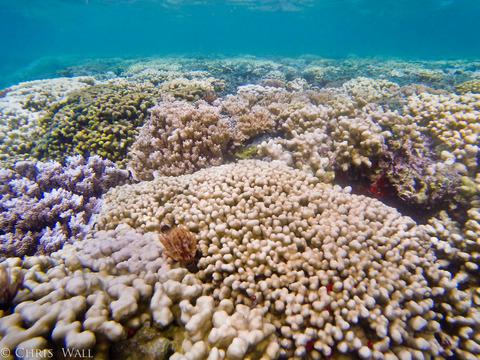当前位置:
X-MOL 学术
›
Funct. Ecol.
›
论文详情
Our official English website, www.x-mol.net, welcomes your
feedback! (Note: you will need to create a separate account there.)
Shifting baselines: Physiological legacies contribute to the response of reef corals to frequent heatwaves
Functional Ecology ( IF 4.6 ) Pub Date : 2021-04-04 , DOI: 10.1111/1365-2435.13795 Christopher B. Wall 1, 2 , Contessa A. Ricci 3 , Alexandra D. Wen 1, 4 , Bren E. Ledbetter 3 , Delania E. Klinger 3 , Laura D. Mydlarz 3 , Ruth D. Gates 1 , Hollie M. Putnam 5
中文翻译:

改变基线:生理遗产有助于珊瑚礁对频繁热浪的反应
更新日期:2021-06-08
Functional Ecology ( IF 4.6 ) Pub Date : 2021-04-04 , DOI: 10.1111/1365-2435.13795 Christopher B. Wall 1, 2 , Contessa A. Ricci 3 , Alexandra D. Wen 1, 4 , Bren E. Ledbetter 3 , Delania E. Klinger 3 , Laura D. Mydlarz 3 , Ruth D. Gates 1 , Hollie M. Putnam 5
Affiliation

|
- Global climate change is altering coral reef ecosystems. Notably, marine heatwaves are producing widespread coral bleaching events that are increasing in frequency, with projections for annual bleaching events on reefs worldwide by mid-century.
- Responses of corals to elevated seawater temperatures are modulated by abiotic factors (e.g. environmental regimes) and dominant Symbiodiniaceae endosymbionts that can shift coral traits and contribute to physiological legacy effects on future response trajectories. It is critical, therefore, to characterize shifting physiological and cellular states driven by these factors and evaluate their influence on in situ bleaching (and recovery) events. We use back-to-back bleaching events (2014, 2015) in Hawai'i to characterize the cellular and organismal phenotypes of Montipora capitata corals dominated by heat-sensitive Cladocopium or heat-tolerant Durusdinium Symbiodiniaceae at two reef sites.
- Despite fewer degree heating weeks in the first-bleaching event relative to the second (7 vs. 10), M. capitata bleaching severity was greater [bleached cover: ~70% (2014) vs. 50% (2015)] and environmental history (site effects) on coral phenotypes were more pronounced. Symbiodiniaceae affected bleaching responses, but immunity and antioxidant activity was similar in all corals, despite differences in bleaching phenotypes.
- We demonstrate that repeat bleaching triggers cellular responses that shift holobiont multivariate phenotypes. These perturbed multivariate phenotypes constitute physiological legacies, which set corals on trajectories (positive and/or negative) that influence future coral performance. Collectively, our data support the need for greater tracking of stress response in a multivariate context to better understand the biology and ecology of corals in the Anthropocene.
中文翻译:

改变基线:生理遗产有助于珊瑚礁对频繁热浪的反应
- 全球气候变化正在改变珊瑚礁生态系统。值得注意的是,海洋热浪正在产生广泛的珊瑚白化事件,而且频率越来越高,预计到本世纪中叶,全球珊瑚礁每年都会发生白化事件。
- 珊瑚对海水温度升高的反应受非生物因素(例如环境制度)和占主导地位的共生科内共生体的调节,这些内共生体可以改变珊瑚的特征并有助于对未来反应轨迹的生理遗产影响。因此,表征由这些因素驱动的不断变化的生理和细胞状态并评估它们对原位漂白(和恢复)事件的影响至关重要。我们用背来背在夏威夷漂白事件(2014年,2015年)来表征的细胞和机体的表型蔷薇结球甘蓝由热敏感为主珊瑚Cladocopium或耐热的Durusdinium在两个珊瑚礁点Symbiodiniaceae。
- 尽管相对于第二次(7 对 10),第一次漂白事件中的加热周数较少,但M. capitalata漂白的严重程度更高 [漂白覆盖率:~70% (2014) vs. 50% (2015)] 和环境历史(场地效应)对珊瑚表型的影响更为明显。共生科影响漂白反应,但所有珊瑚的免疫和抗氧化活性相似,尽管漂白表型存在差异。
- 我们证明重复漂白会触发细胞反应,从而改变全生物多变量表型。这些扰动的多元表型构成了生理遗产,将珊瑚置于影响未来珊瑚性能的轨迹(正面和/或负面)上。总的来说,我们的数据支持在多元背景下更好地跟踪压力反应的必要性,以更好地了解人类世珊瑚的生物学和生态学。











































 京公网安备 11010802027423号
京公网安备 11010802027423号